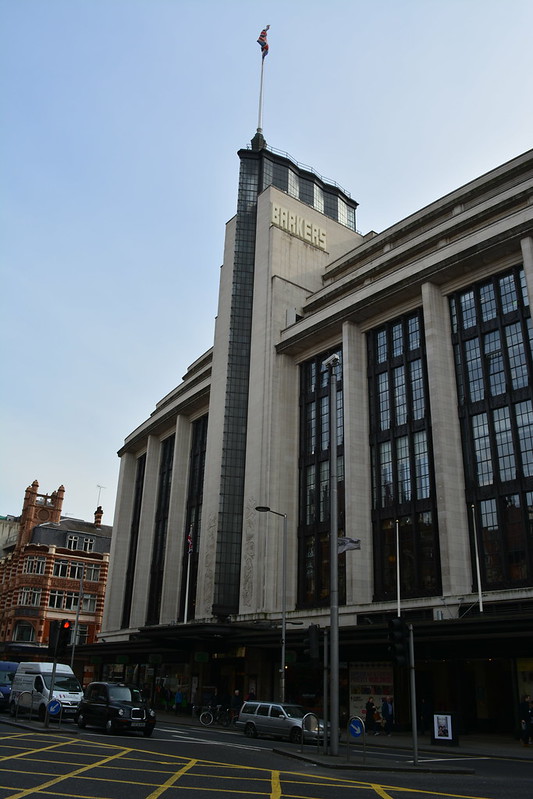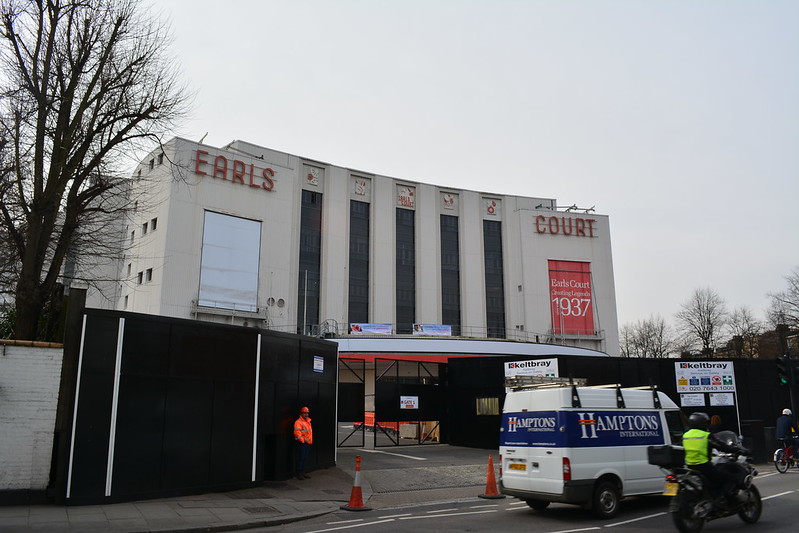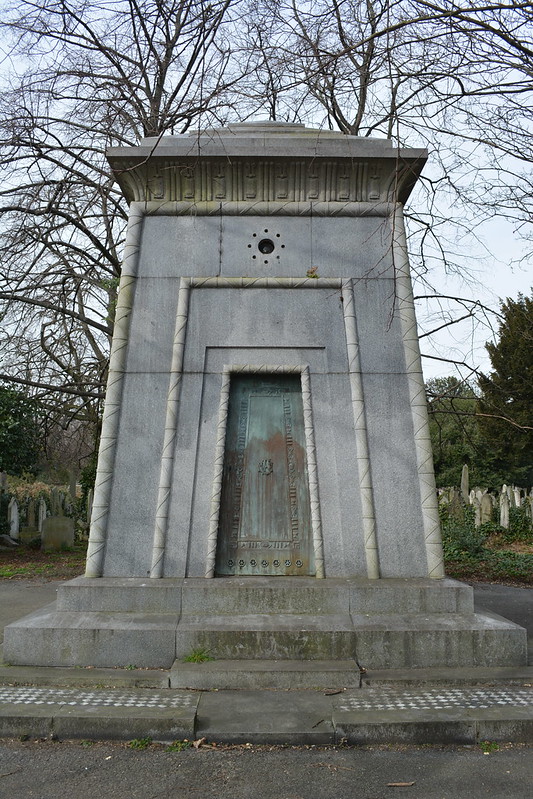As a break from my usual urban explorations and in support of two good friends and their favoured charity I agreed, drink must have been involved, to do a 25km sponsored walk along the river Lea from Hertford to Enfield Lock.
The original idea was to do a 25 mile walk, in celebration of their 25th wedding anniversary, but it was pointed out that none of us had really done enough training for this and also that the length of the day in October might not be sufficient for us to complete the walk without torches.
So the day rolled around and I was recovering from a really heavy cold but still managed to drag myself out of bed at 05:15 in order to be at Hertford by 09:30 on a very foggy and chilly October morning.
Hertford itself is a very pleasant town which still exhibits a partial medieval street plan and a fine selection of buildings in a variety of styles. I was able to pontificate on the pargeting on some of the buildings in the town centre.
A fine breakfast at a local bar set us up for the walk and we headed off to the tow-path that runs beside the Lea which is part river and part canal. After about an hour the fog burnt off and the day turned bright and warm. This combined with good quality walking conditions underfoot (mainly gravel and tarmac with some very short stretches of muddy grass) meant that we made good progress.
One of the most interesting places we passed was Ware which is famous for its riverside gazebos.
I decided on this walk not to take my camera so there are no photos of the swans, ducks, moorhens, coots and other wildlife we saw, all I have to remember the journey by is a couple of huge blisters. Nor are there pictures of the speeding cyclists that seemed to be out in droves (what is the collective noun for cyclists? A chain? A hazard? A lycra?).
The further south we went the less interesting the scenery unfortunately but it was all downhill (very gently apart from at the locks) so when we eventually reached our journeys end we didn't feel too exhausted but were glad that it was only a short walk to a local pub (the Greyhound - home to 'eyebrow' Terry) and then a stiff legged hobble to the train station for, in my case, the long journey home.
A goodly sum was raised for charity, much laughter was had due to most of us not being to speak or hear clearly for one or other reason which led to a conversation around whether a GPS walk tracker was best kept in a dwarf or on an elf, so all in all it was a great day.
Normal service will be resumed next month with the next leg of my tube walk and possibly some strolls in the Cotswold Hills.
Tuesday, 6 October 2015
Five Go Mad On A Towpath
Labels:
canal,
gazebos,
Lea Valley,
Samaritans,
sponsored walk,
tow-path
Greenford, London
Hertford, UK
Tracking the Tube: Northern Line 02: Kennington - Euston - Kennington
Weather: Very warm for the end of September with lots of sunshine.
Distance Walked: 20.75km
Distance By Tube: Technically 0km but 13.43km in reality.
Stations Visited: 18 (or 19 if you include Kennington twice!)
Fantastic Place: Borough Market
 A perfect day for walking on what turned out to be one of the most enjoyable walks so far in this set of Tube walks. This is partly because of the lovely sunny weather and also it took me through what I regard as 'my London'.
A perfect day for walking on what turned out to be one of the most enjoyable walks so far in this set of Tube walks. This is partly because of the lovely sunny weather and also it took me through what I regard as 'my London'. |
| 18 stations on this leg |
I started out from Kennington, again getting confused by the lift where you get out of the same door you enter through unlike most lifts on the underground. The dome on top of the station was designed to house all the heavy lift machinery - it is nice when function produces an attractive form. Its a shame that some of the tower blocks I saw on today's walk didn't achieve this goal (yes I'm looking at you Mr Walkie-Talkie building).
First up was the maze of streets, roadworks, underpasses, coned and fenced off walkways that make up the Elephant and Castle roundabout.
 |
| Pink Elephant before 10am and I hadn't been drinking |
Obviously they are doing improvement works and hopefully things will be better soon but at one point I didn't think I'd escape and I wasn't sure where I should be heading.
Anyway I soon put this behind me and it wasn't long before Borough Market came into view. I used to work in the area and one way of relieving the stress of the day was to pop down and stroll around the stalls and perhaps pick something up for supper. If anything the market has got larger and busier in the past few years and is a great place to spend an hour or two. Buy some cheese, some cured meats, some bread,
 |
| Borough Market Greengrocer Stall |
Continuing along the high street I passed the George Inn, the last galleried inn in London and it does good food and drink as well though it was far too early to stop there today!
London Bridge station is a sprawling mass of underground and overground lines spread over a large area right next to London Bridge. London Bridge itself has seen many incarnations from the famous one with houses and shops lining it as seen in many a picture of the Frost Fairs on the Thames to the version that a rich American bought and set up on a lake somewhere in the USA to the bland modern version that stands today.
 |
| Here be dragons |
A short distance across the bridge is Monument station named for the monument to the great fire that stands nearby. Next up is Bank named for the Bank of England, the Old Lady of Threadneedle street which stands pretty much on top of the station.
The streets here still follow the old medieval street pattern and they twist and turn, zig and zag in the shadow of the towers of the banks and other financial institutions leaving the streets shaded like canyons.
More extensive roadworks and diversions around Moorgate for the long planned Crossrail project that will hopefully reduce some of the load on the Central line in a few years time follow before I reach Moorgate station.
Continuing North and West in a series of long dog-legs towards Old Street station I came across Bunhill Fields a non-conformist burial ground that is the last resting place of William Blake and Daniel Defoe amongst others. Well worth a detour if you are in the area it is a peaceful oasis amongst the hustle and bustle that surrounds it.
Old Street was where I did my initial training in IT after I left teaching. The area has developed since then and is now known as Silicon Roundabout because of all the tech startups there are there now. A bit further north-west along the City Road, opposite my old office, is the Eagle pub. Famous for being the pub mentioned in pop-goes-the-weasel. In my day it was a bit of a dive and we used to use the cafe nearby, the Shepherdess, which also seems to have gone up in the world in the last twenty odd years!
 |
| Regent's Canal |
The route between Angel and Kings Cross took me through the picturesque Percy Circus. Built on a very steep hill the houses around the circular green are very attractive and there is a blue plaque nearby commemorating Lenin who lived/stayed in one of the properties for a time.
A very windy and dull stretch along the Euston road followed where in quick succession Kings Cross, Euston and Warren Street stations were ticked off the list but I had passed half way.
Turning south I enter what I regard as part of my London and it has been pretty much ever since I moved to the city after completing my teaching qualifications in Norwich. This is a landscape of galleries, bookshops, theatres, opera houses and places to eat and I think I know my way around here fairly well.
 |
| A Home Form Home! |
 |
| The Home of the ENO |
Shortly after Leicester Square station I passed the Colosseum home of the English National Opera and the national Portrait Gallery - two more of my favourite places in this part of London.
Carrying on south past Charing Cross station and through Embankment I recrossed the river via Hungerford Bridge and then dropped down on the south side of the river towards Waterloo.
 The South Bank was busy with fun fairs and performers which it seems to be more often than not these days which goes some way to hide the rather unattractive concrete buildings of the Festival Hall etc built for the Festival of Britain back in the 50s.
The South Bank was busy with fun fairs and performers which it seems to be more often than not these days which goes some way to hide the rather unattractive concrete buildings of the Festival Hall etc built for the Festival of Britain back in the 50s.The roads around Waterloo were busy and I got a bit lost as I have done in the past, though I did manage to spot an unusual sculpture outside one of the hotels.
Turning back towards Kennington I looked back and caught a fine view of the Houses of Parliament framed by the London Plane trees that line this part of the river near Lambeth Palace.
 |
| The Houses of Parliament |
I was ready for a break when I got back to Kennington tube after what was quite a long walk, made longer by the crowds in the centre and the number of stations and points of interest to take photos of.
Next leg will see me heading north but not before I do a 25km sponsored walk along the River Lea with some friends in aid of the Samaritans.
Labels:
canal,
Dungeons and Dragons,
food and drink,
London,
markets,
Northern Line,
Opera,
Parliament,
Sculpture
Greenford, London
Kennington, London SE11, UK
Tuesday, 15 September 2015
Tracking The Tube: Northern Line: 01: Morden to Kennington
Weather: Mild becoming very warm and sunny as the walk progressed
Distance Walked: 18.2 km
Distance By Tube: 11.9 km
Stations Visited: 12
Fantastic Place: Kennington Oval
 |
| Northern Line Map |
 | |
| Stations on this leg - spot the missing one! |
Decided to walk from south to north to give me more time to consider how I was going to handle the odd branching nature of the 'top end' of the line. I'd never been as far south as Morden before and I was very pleasantly surprised. The station itself, like many of the others has a Modernist design by Charles Holden as do many of the others on this leg of the walk. In fact there is a Charles Holden pub opposite Colliers Wood station. The interior of the station is dominated by a large octagonal skylight, while the outside is unfortunately marred by the busy bus depot and shops. My next surprise was Morden Hall Park, a National Trust property (and a cafe) which will probably get a visit of it's own at a later date.
A stroll through wild meadows and across the tram lines (trams are very nearly silent and they can catch you unaware) leads you to a peaceful stretch of walking along the River Wandle.
 |
| River Wandle |
I hadn't realised that this area had such strong link with Nelson but there were several pubs with his name, the Victory and Trafalgar and then in a small area of open space this memorial stone.
 |
| Memorial Stone |
South Wimbledon and Colliers Wood stations come and go as you move from the peace and quiet of the Wandle to the hustle and bustle of a main road that climbs gentle but continuously past shops and markets from Wimbledon to Tooting.
Branching off the high street after Tooting Bec I walked through Tooting Bec common where today's root crossed that of the Capital Ring, I thought the park looked familiar.
Returning back to the high street at Balham the climb continued to Clapham South and the wide open expanse of Clapham Common. The tube stations here (Clapham Common, Clapham South and Clapham North were used as deep-level shelters during WW2. Above ground there is little to see other than the drum shaped shelter entrances.
 |
| Clapham North Deep level Shelter Entrance |
 |
| Clapham Common Bandstand |
The road continues on and on and now into more familiar territory for me as I have worked in the Vauxhall area for several years now. Stockwell Station is one of the few on this leg that is not to the Charles Holden design. Oval station is of course near the Kennington Oval cricket ground (England was winning the Ashes elsewhere as I was walking past it). The ground itself is not visible from the road but the old stands and the gasometers (a sight that I remember from my childhood watching the cricket on the telly during the summer school holidays, when the Vauxhall Road End sounded a lot more exotic than I know know it to be) are. The last station on this leg, Kennington is a pretty little one with a domed roof and a very cramped ticket office with little room for the lifts that need to serve the deep level platforms.
Next leg will be the Kennington - Euston - Kennington loop.
Labels:
Charles Holden,
Clapham,
Northern Line,
Tube,
WW2
Greenford, London
Clapham, London SW4, UK
Tuesday, 4 August 2015
Tracking The Tube: District Line: 05: East Ham to Upminster
Weather: Warm and Sunny to start, becoming cloudy and windy later
Distance Walked: 18.65km
Distance By Tube: 14.63km
Stations Visited:10
Fantastic Place: Mayesbrook Park

 |
| This leg's stations |
The walk started by passing through rows of terraced Victorian and Edwardian houses, a theme that would recur through most of the walk, though the quality and size of the properties varied and towards the end the terraces were replaced by larger, semi-detached houses with some interesting details (arched and round windows and brick detailing).
Crossing the very busy North Circular by a footbridge with very awkward shallow steps the next stretch was through a rather unattractive light industrial estate. There were a lot of men hanging around outside Wickes (DIY suppliers) with boxes of tools and occasionally a white van would pull up and a talk to the men and some would get in. I assume that this is a known pick up point for day-labourers. Not much security of income and slightly reminiscent of the way that dock labourers used to be employed.
Barking appears to have been tidied up a bit from when I used to visit on a regular basis with new modern apartments and a vibrant street market with food and shoes being a particular strength of the bit I walked through. Barking station is not attractive, but then none of the stations on this leg were, most being the brick box with flat concrete roof. Barking and Upminster being larger interchange stations were even less attractive than that!
Past Barking Hospital and Upney station the route entered the very attractive Mayesbrook Park. Two large lakes with numerous swans, ducks and geese. It was like a mini Barnes WWT site!
 |
| Large Lake in Mayesbook Park |
 |
| Grazing Goose |
Along the long Rugby road to Becontree station I started to notice something I've not seen very much of in London - decorative cement rendering. In the country, if it was done in plaster it would be called pargeting. I used to see a bit of this when I lived in Norwich and it is common in Suffolk and Essex so I shouldn't be surprised to see it on houses on this leg of the walk, it just looks a bit incongruous on a thirties semi!
 |
| One of many houses with pargeting |
In the same area I saw the fastest sprayer in the east! On his little buggy this guy was spraying the gullies to control weeds. The car tyres of the residents should also be proof against bindweed etc. as he was not too careful as to where his wand was spraying as he zoomed along the pavement!
 |
| Ernie and he drove the fastest sprayer in the east! |
Dagenham Heathway and Dagenham East followed with much more suburban streets before a very wild section running between high fences. To the south it looked like derelict factories while to the north empty parking lots. I assume these were linked with the Ford motor works that were based in Dagenham. After a while the fences were hidden by damson trees, elderberry, hawthorn, wild roses and blackberries. In a week or two you could come down and make a very handy wild harvest here.
 The path led into the Chase Nature Reserve a wild area of hummocks, horse droppings and wild life. I almost got twizzled around in this section but found my way out and rejoined the route to Elm Park station.
The path led into the Chase Nature Reserve a wild area of hummocks, horse droppings and wild life. I almost got twizzled around in this section but found my way out and rejoined the route to Elm Park station.After stopping for a sandwich as the wind picked up and the clouds gathered I headed along through tree lined streets and larger semi detached properties (and more pargeting) to Hornchurch and Upminster Bridge where the route briefly joined the LOOP.
The last stretch from Upminster Bridge was uphill and I passed Upminster Windmill just before reaching Upminster station and the long journey back to Greenford.
That's the end of the District Line, now for the Northern Line starting at the south end and working my way north.
Labels:
birds,
District Line,
ducks,
geese,
lake,
pargeting,
park,
stations,
swans,
wild harvest,
windmill
Greenford, London
Dagenham, Greater London, UK
Wednesday, 1 July 2015
Tracking The Tube: District Line: 04: Monument to East Ham
Weather: Very Warm and Humid
Distance Walked: 16.68km
Distance By Tube: 10.73km
Stations Visited:12
Fantastic Place: The Tower of London

 | ||
| 12 Stations on this leg with no coherent design |
After leaving Monument station (having this time been directed underground from bank up and down untold numbers of short flights of stairs and escalators) I headed towards the Tower of London. I remember going in there when I was young but haven't been in since I moved to London as it is so expensive. The area around the Tower has been tarted up a bit since I last walked through and you can get a good view of the buildings from the walk up towards Tower Hill station.
 |
| Buildings Ancient and Modern |
 |
| The Tower of London |
 | |
| Emperor Trajan by the Roman Walls |
Attractive Victorian Pub
The Whitechapel Road follows the route of an old Roman road heading out to Colchester and parts of it look like they haven't been resurfaced since then while other parts are undergoing major roadworks. I have never seen so many cones and orange plastic fences! The walk follows this road all the way to Bow Road.
 | ||
| Don't think is a real ancient column |
After Stepney Green station the route passes under Mile End Park where they have built a green bridge over the road linking the two haves of the pub just after the road passes over the Regent's Canal.
 |
| View down the Regent's Canal |
 |
| Green Bridge linking two halves of a park. Note the cones! |
The next section was one of my least favourite so far. Very hot and alongside the very busy A12 south towards Bromley By Bow station then back north looking for an underpass across to the far side of this major trunk road.
Once through a light industrial estate you enter the River Lea valley a collection of riverways and canals, a peaceful change from the roads barely a hundred yards away.
 |
| Three Mills |
As well as the canal architecture, peaceful waterways with birdsong and views across to the Olympic Park there is quite a bit of sculpture lining the route.
 |
| Memorial to workers killed by bad air |
 |
| Not sure who this was |
After getting lost, retracing my steps and then having to re-retrace them when discovering that the Greenway is partially closed I eventually reached West Ham station before rejoining the Greenway for a stretch. The views from the Greenway are splendid and it should be far better known and used than it is.I took an ill-advised short cut to Plaistow station ending up walking the same distance but in less interesting surroundings before heading on to Upton Park. Couldn't resist taking a shot of the Boleyn Ground on y way. As I was heading up to Upton Park station (prettiest station on this leg by the way) I saw what I assumed to be a traditional East End funeral; a horse drawn hearse with black ostrich plumes and a train of six or seven long black limos.
 |
| Upton Park / Boleyn Ground Home (for now) of West Ham United |
I hope to be able to complete the rest of the District Line on y next walk which will take me through Barking and out to the utter east.
Labels:
architecture,
canal,
football,
greenway,
pub,
Roman Road,
Roman wall,
stations,
Statues,
tourist sites,
tower of London
Saturday, 2 May 2015
Tracking The Tube: District Line: 03: Turnham Green to Monument
Weather: Warm and sunny
Distance Walked: 19.2km
Distance By Tube: 13.31km
Stations Visited:19
Fantastic Place: Natural History Museum

 |
| 19 Stations on this Leg |
 |
| Magnolia in Bloom |
Nice sunny day today and getting quite warm by the time I stepped out at Turnham Green station, which appears to be disguised as a flower stall. The flowery theme continued as I headed towards Stamford Brook with lots of Spring blossom, wisteria, Bachelor's Button and magnolia in bloom.
The route took me past the former nurses' home of the Royal Masonic Hospital, a wonderful Grade II listed building built in the 1930's with all the style and brutal grace that implies. Now converted into luxury apartments which I would imagine sell for a pretty penny.
There are a wide range of styles of station building on this part of the district line. From the humble, warm, red brick ones like Ravenscourt Park (one of my favourite Tube Station Charades that I am for some reason asked to do each Christmas Games) through to the modern glass construction of Bishopsgate via the granite fronted, almost hidden entrances of Mansion House. Not sure why this line doesn't have a consistent style like some of the other lines.
Ravenscourt Park itself is another of the great green spaces that I've come across on my various London walks (and fortunately there are far more of these and far less golf courses this far into the city) and it was thronged with children on half term and mothers with prams taking in the balmy spring weather. A very nice garden centre lies near the exit of the park and the entrance to the station which will do brisk business over the next couple of of Bank Holiday weekends no doubt.
Passing under the elevated section of the A4 took me past one of three venues at which I have seen
 |
| It will always be the Hammersmith Odeon to me! |
It seems a theme of my walks recently have been hospitals and again on this leg I passed one, Charing Cross to be precise which is right up against the large Margravine Cemetery and the Queens Club tennis court. Barons Court station is one of the more attractive stations, warm soft orange sandstone with ornate lettering. An area of mansion flats follow including the former residence of Mahatma Gandhi before West Kensington station arrives, a small building on the bridge over the tracks.
Passing Earls Court Exhibition Centre (second gig venue of the leg - saw Pink Floyd there) via a very attractive crescent of buildings with pollarded limes and London Planes before arriving at the other end of Earls Court station from the previous leg.
A stretch of very attractive squares with fenced in communal gardens all full of attractive trees and shrubs, gravel paths and neatly tended bedding follow before Gloucester Road station appears. This is another attractive building built in two styles, a ox-blood red one more reminiscent of the Metropolitan line and a taller yellow brick built building with mosaic lettering below the roof line.
 |
| Natural History Museum - London |
No time to stop today however and so after South Kensington station (with its ornate ironwork entrance), not using the Museum Tunnel this time, there is a longish stretch towards Sloane Square. This included a very attractive stretch around Sprimont Place which includes Grade II listed buildings (Arts and Crafts?) and a lovely village like feel with small shops (including nice looking cheese and fish shops).
 |
| Cadogan Hall |
Sloane Square is best seen around Christmas at night where the trees are all decorated with balls of light. During a bright day the place is a bit like a busy island in the middle of a roundabout despite the upmarket shops and restaurants (and Peter Jones!) that line the streets around the station.
Its a return to quiet residential streets after leaving the hustle and bustle of Slone Square but only for a while. The area around Victoria station is a mass of building sites and busy roads (hence the rubbish picture of the tube station - the street is very narrow there with lots of big lorries going back and forth delivering and taking away materials.
Passing the stripy edifice that is Westminster Cathedral (not to be mistaken for Westminster Abbey which comes up shortly) the busy Victoria Street leads to the heart of political London as it passes St James Park Station and the now sold off New Scotland Yard (not sure if the next base of the Metropolitan Police Force will be called Brand Spanking new Scotland Yard or not) with the Palace of Westminster, Portcullis House and Westminster Abbey all in close proximity. In fact despite living in London for over half my life I hadn't realised that Westminster Abbey was quite so close to the Houses of Parliament! The place was heaving with tourists and Westminster Station itself, though interesting inside being one of the modern ones for the Jubilee Line extension is rather drab on the outside.
 |
| Oliver Cromwell |
 |
| The Elizabeth Tower |
 |
| Westminster Cathedral |
 |
| Arthur Sullivan Bust in Victoria Embankment Gardens |
Next up is Temple Station which serves the Inns of
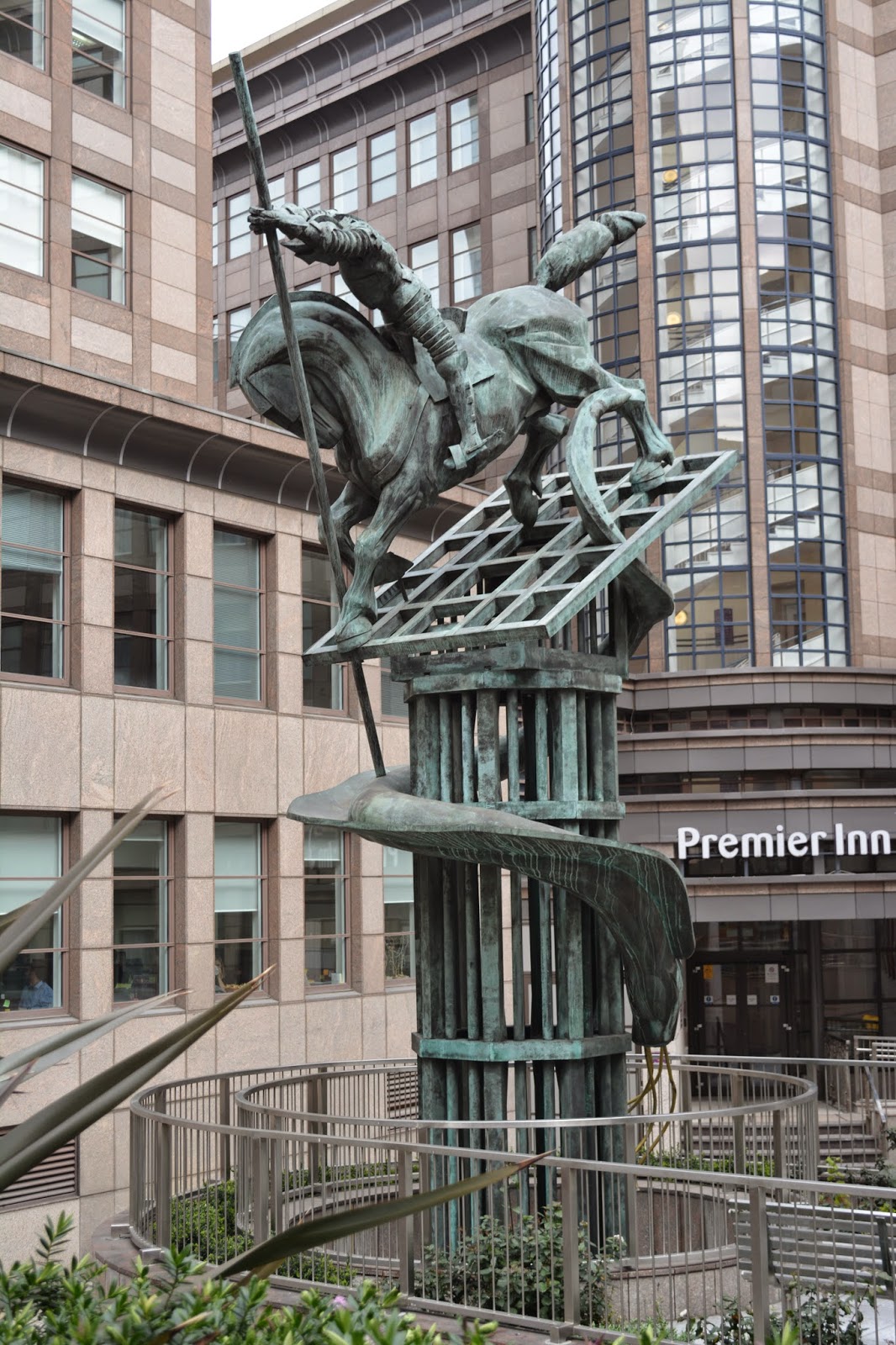 |
| St George and the Dragon |
Cannon Street and Monument come up quickly and are again modern buildings with little grace or style, the latter being very close to the Monument which marks the start of the Great Fire of London. I've climbed it once and the views are spectacular. I also did a walk that went from the Monument to the furthest edge of the Great Fire taking in many interesting places on the way.
That marked the end of this leg of the walk as it was only a short distance to Bank station for a simple journey back to Greenford on the Central Line. The tube was crowded with an odd mix of suited businessmen and costumed children who had just come from a performance of Frozen!
Labels:
art nouveau,
Arthur Sullivan,
cathedral,
District Line,
govenment,
law,
Marillion,
Sewers,
Show of Hands,
stations,
Statues
Sunday, 15 March 2015
Tracking The Tube: District Line: 02: Edgeware Road to Wimbledon
Weather: Nice and sunny but with a bit of a lazy wind
Distance Walked: 20.8
Distance By Tube: 15.09
Stations Visited:15
Fantastic Place: West Brompton Cemetery
 |
| 15 Tube Stations on the leg of the walk |
For the second leg of my District Line walk I skipped a bit eastward so I could do the other north-south branch from Edgeware Road to Wimbledon, fifteen stations including a detour to take in Kensington Olympia on it's seldom used branch line from Earl's Court.
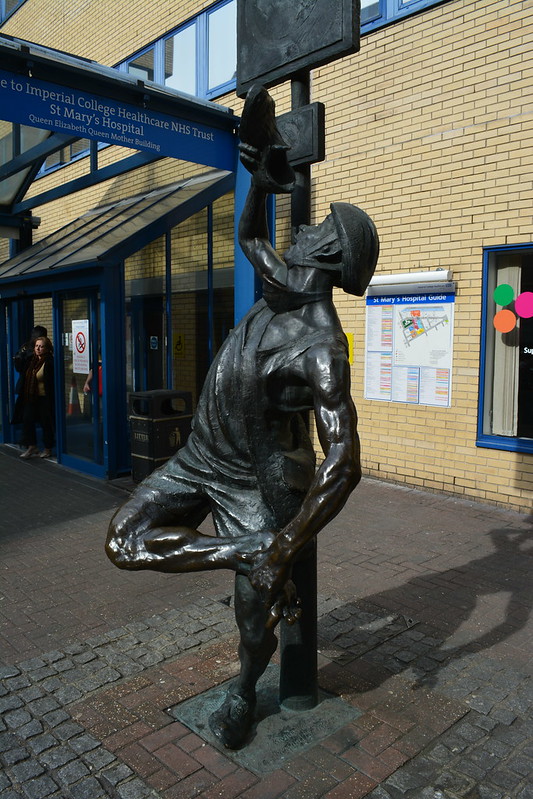
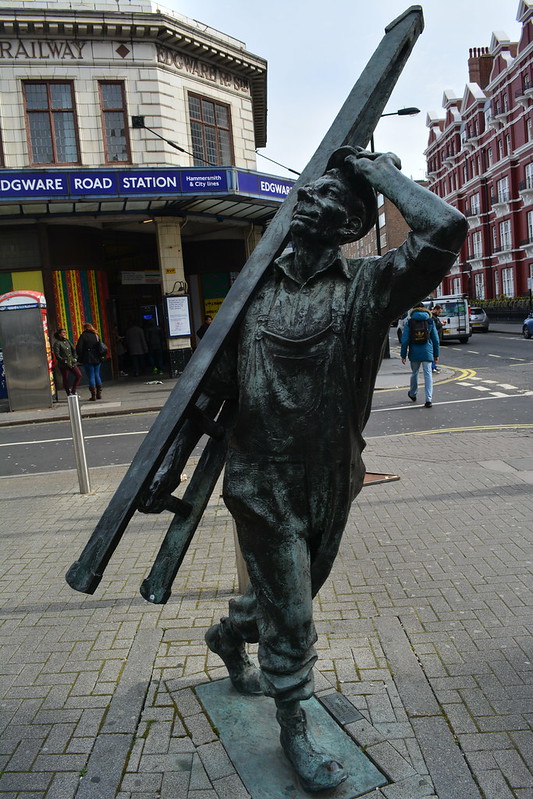 There are two Edgeware Road stations, this is the more attractive of the two and has what appears to be the standard, for this part of the line, pale cream glazed brickwork frontage. Interestingly this station was originally part of the Metropolitan railway but now serves the District, Circle and Hammersmith & City lines. Just outside the station was the first of two interesting pieces of public sculpture I was to see on this section of the line.
There are two Edgeware Road stations, this is the more attractive of the two and has what appears to be the standard, for this part of the line, pale cream glazed brickwork frontage. Interestingly this station was originally part of the Metropolitan railway but now serves the District, Circle and Hammersmith & City lines. Just outside the station was the first of two interesting pieces of public sculpture I was to see on this section of the line.The stretch down to Paddington Station passes through the sprawling buildings of one of London's teaching hospitals, St Mary's, very useful if you are playing a game of Pointless in your head trying to find words beginning with a vowel and ending with 'ology'.
Another sculpture outside of the hospital of a cyclist checking his shoe. Odd.
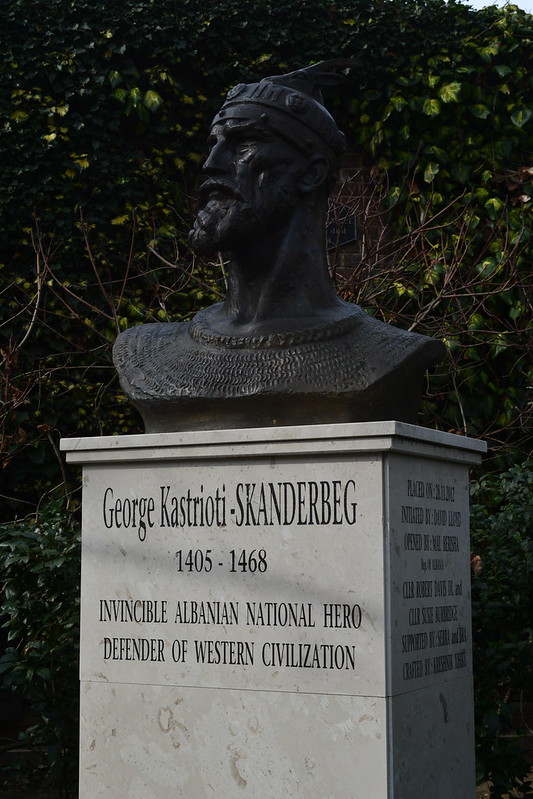 Through the seemingly endless streets of Bayswater lined with stylish mansion flats and squares filled with spring bulbs and early cherry blossom in shades of pink and white and on the corner of one of these streets, the rather fine bust of George Kastrioti-Skandburg.
Through the seemingly endless streets of Bayswater lined with stylish mansion flats and squares filled with spring bulbs and early cherry blossom in shades of pink and white and on the corner of one of these streets, the rather fine bust of George Kastrioti-Skandburg.Bayswater station followed soon after and I was soon in little Athens with a domed Greek Orthadox cathedral and lots of Greek grocery shops.
After Notting Hill Gate station my path took me along Kensington Palace Gardens, part of the Crown Estate, and signs told me in no uncertain terms not to take any photos. Again this was useful practice for Pointless as I tried to guess the embassy from the flag flying outside. Some were simple, Japan, Finland, Russia, others less so, Nepal for example. Israel's was probably the easiest to identify as it was the only one with two Met police officers armed with semi-automatic weapons standing outside.
I moved swiftly on...
High Street Kensington was busy as lunchtime was approaching and there were plenty of interesting buildings in the Art Deco style to admire as I headed back west towards Kensington Olympia. The most striking building was probably Barkers.
The old Commonwealth Institute is being knocked down / refurbished to become part of the design museum. It was one of the first museums I went to when I moved to London, an interesting building but prone to leaks if I recall correctly.
Kensington Olympia doesn't have a proper sign so I included in the montage the sign that gives it's original name Kensington Addison Road instead.
Heading south east the streets are busier and everything appears a little more shabbier as I arrived at Earl's Court. This was where I saw my first gig, Pink Floyd performing "The Wall." Now the whole exhibition centre is being knocked down to provide non-affordable housing. Shame, many great memories have seeped into the concrete walls of that edifice.
West Brompton is the next station, from the top floors of the nearby Empress State Building (a former client was based there for time) you have a great view down onto the pitch of Stamford Bridge, home of Chelsea Football Club.
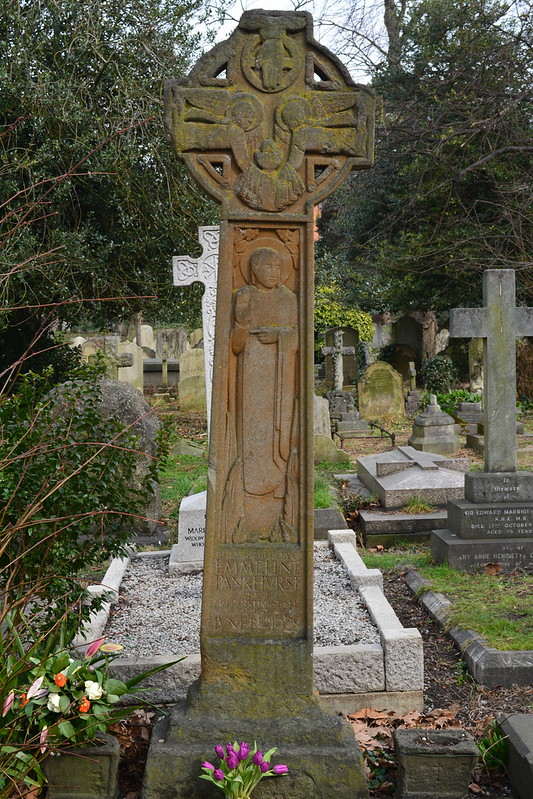 The next stretch takes you through the slightly wild and overgrown West Brompton Cemetery. Lots of family tombs, vaults and mini-mausoleums line the main route including the grave of Emmeline Pankhurst. Some of the tombs would make great entrances for a Dungeons and Dragons game!
The next stretch takes you through the slightly wild and overgrown West Brompton Cemetery. Lots of family tombs, vaults and mini-mausoleums line the main route including the grave of Emmeline Pankhurst. Some of the tombs would make great entrances for a Dungeons and Dragons game!After leaving the cemetery you walk round the perimeter of the football ground which sprawls around a bit. The outside of the complex itself is rather an ugly monstrosity at ground level and looks better from above.
The original Fulham Broadway station was a grand brown stone building but this is now closed and the station is buried within a steel and glass shopping centre. Ho hum.
Passing over the interestingly named Eel Brook Common open space, past Parson's Green station and then Parson's Green itself I felt a little deja vu as this reminded me of the Turnham Green and Chiswick Park section with small common areas with the tube line running on an embankment close by.
Putney Bridge station followed soon after and then up a flight of steps to a footpath that runs alongside the train tracks across the Thames, the tide was out, with great views down the river.
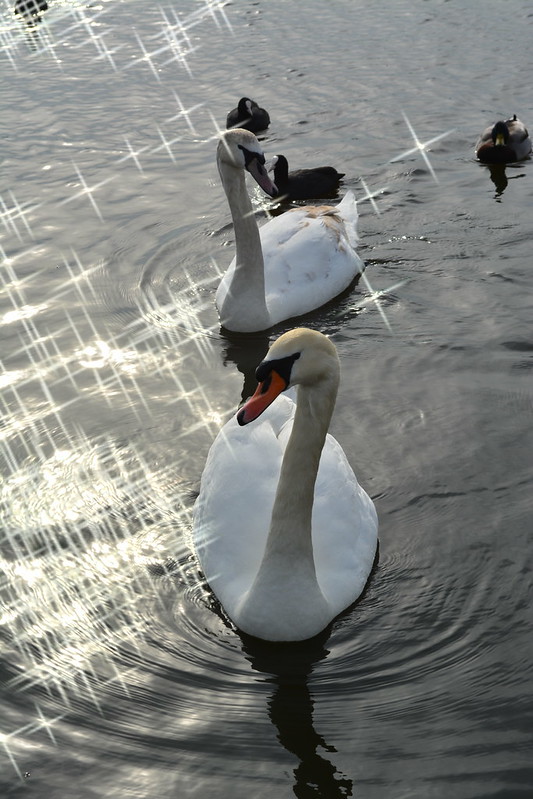 South of the river the stations change in style, becoming quaint brick built buildings with the logo of the London and South West Railway above the entrance in carved brickwork along with the date of opening (around 1889-1890) the same date as the building of the railway bridge. Past Southfields the route enters Wimbledon Park which I visited on the Capital Ring walk. The pond was full of ducks and swans being fed by young children well wrapped up against the wind that blew unobstructed across the water. But with the sun reflecting off the ripples and the bulbs and blossom on the trees this was a very enjoyable respite from the suburban streets surrounding it.
South of the river the stations change in style, becoming quaint brick built buildings with the logo of the London and South West Railway above the entrance in carved brickwork along with the date of opening (around 1889-1890) the same date as the building of the railway bridge. Past Southfields the route enters Wimbledon Park which I visited on the Capital Ring walk. The pond was full of ducks and swans being fed by young children well wrapped up against the wind that blew unobstructed across the water. But with the sun reflecting off the ripples and the bulbs and blossom on the trees this was a very enjoyable respite from the suburban streets surrounding it.Somehow the rod climbs steeply from Wimbledon Park station up Arthur Road to the last stop on this leg of the walk Wimbledon Station.
Next I will return to Turnham Green and explore the District Line as it follows the line of the Thames through the city and out the other side into the lesser known, to me anyway, reaches of Dagenham and Upminster.
Labels:
Albania,
Art Deco,
Chelsea,
District Line,
Dungeons and Dragons,
football,
graveyards,
music,
Pink Floyd,
Putney,
Sculpture,
Thames,
Wimbledon
Subscribe to:
Posts (Atom)

